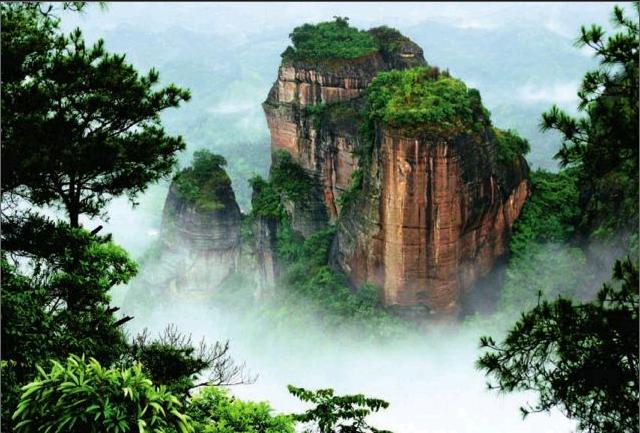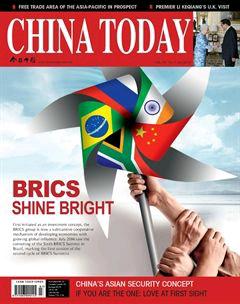Wuzhou: Lingnan’s Most Memorable City
By+WU+MEILING



THE ancient city of Wuzhou is regarded as the cradle of two provinces. Emperor Taizong (993-997) of the Song Dynasty (960-1279) demarcated the area to the east of Wuzhou as Guangdong, and the western area as Guangxi. Today the city is known for its elegant natural scenery and industry as well as its antique culture. It has been recognized as a National Forest City, a world capital of artificial gemstones and a national model for recycling and green energy. Liang Yusheng, a famous Kung Fu novelist, set one of his stories among the spectacular natural wonders of Wuzhou.
Wuzhou is a city built around rivers, and waterways are at the heart of city life. The Xunjiang and the Guijiang rivers join here to form the Xijiang River, which flows eastward to Guangdong and empties into the South China Sea. With over 4,000 years of civilization and a city over 2,000 years old, Wuzhou stands out as one of Chinas most celebrated towns.
The citys name dates back to the primitive Cangwu tribe under the reign of emperors Yao and Shun. Cangwu was so named for the abundance of Chinese parasol trees (wutong) and their dark green (cang) hue. Historically, Wuzhou was an important trading port on the Maritime Silk Road. Originally called Guangxin County, the area was renamed Cangwu under the Sui Dynasty (581-618) in 583. The name Wuzhou first appeared during the Tang Dynasty (618-907) in 621.
Wuzhou is also famous as the resting place of the legendary Emperor Shun, who died while hunting in the wilderness of Cangwu. Shun ruled China around 2000 BC and united the Yellow River Plain with Lingnan (the area south of the Five Ridges mainly including Guangdong and Guangxi). In his waning years, Shun made an inspection tour of Cangwu and spread the culture of the Central Plains area to the uncivilized territory. However, after many difficult travels, Shun died and was buried in the Baiyun Mountain. His grave has been a celebrated site for literary masters including Li Bai, Du Fu and Su Shi.
Time-Honored Commercial Port
In 221 BC, the fi rst emperor of the Qin Dynasty (221-207 BC) sent 500,000 soldiers to suppress the southern region dominated by the Baiyue people. Benefiting from the Lingqu Canal connecting Chinas north and south rivers, the area south of the Five Ridges was soon incorporated into Qin territory. However, one tribe of the Baiyue people, who lived in the area now includingWuzhou, Yulin and Beihai, rose up in revolt. Then the emperor dispatched a troop of 500,000 soldiers to suppress the revolt, and four years later, sent another half million migrants to defend the restless region. The new residents, fi ve fold the original Baiyue people, made the Central Plains culture take root in the region, and as a fusion of Han and the Baiyue native languages, Cantonese came into being.
In 206 BC the Qin Dynasty collapsed and the country fell into anarchy. The area south of the Five Ridges came under the control of warlords. Zhao Tuo, a general of the former dynasty, established the Nanyue Kingdom in the south region and named his cousin Zhao Guang Prince of Cangwu. Then a castle was built to mark the b eginning of the citys history. It is also the first town built in Guangxi with a historical record. Over 2,100 years ago, when the Lingqu Canal united the Yangtze River system with the Pearl River, the city became the most prosperous trading port in the area south of the Five Ridges. In 1897, during Qing Emperor Guangxus reign Wuzhou was designated a trading port. Thereafter, Wuzhou was the biggest inland trading and commercial port in Guangxi. Today you can still learn about the old city from the former British Consulate on Baihe Hill.
Religion in Wuzhou
Buddhism reached China from India along its ancient trading routes, the overland Silk Road and the Maritime Silk Road. Located at a crossroads of the Maritime Silk Road, Wuzhou was one of the first cities to fall under Buddhist influence. Mouzi of the Eastern Han Dynasty (AD 25-220), a native of Wuzhou, wrote Chinas first Buddhist treatise combining elements of Confucianism and Taoism.
Although Buddhism reached Wuzhou at an early point, the local people still believed in the Dragon Mother religion. For the people of the Pearl River Basin, the Dragon Mother is a powerful local deity in Chinese Taoism. There is a temple to the Dragon Mother located on the bank of the Guijiang River. Built in the Northern Song Dynasty (960-1127) the temple occupies an area of 100,000 square meters, with a statue of the Dragon Mother standing at 38 meters. A statue of Fu Honglie, a well-respected figure from the Qing Dynasty, also stands in the temple. Fu was renowned for his sympathy for the common people and his generous works.
Old Architecture, Everlasting Glory
Because of the flood-prone subtropical climate, arcade houses have been popular in Wuzhou since ancient times. The first floor of an arcade house is typically used as a shop. Its occupants live on the second floor. During floods, resident shop owners could simply pile up bricks and continue business as before. Once water reached the second floor, they fastened boats to the outside walls and used the upstairs windows as doors. The city thus became another Venice. Iron hoops and movable plank doors have both come to symbolize Wuzhou.
Arcade townhouses are located in the old city center. Walking through the town is like stepping into history. Twenty-two streets, lined with 560 arcade houses in different styles, recall the citys antique past. After hundreds of years, the arcade houses are still the citys most charming features.
Cangwu County, “Fossil” of Place Name
Cangwu County under the jurisdiction of Wuzhou City is north of the city. Twenty minutes away from downtown Wuzhou are the famous Liubu tea gardens of Cangwu County. With an area of more than 73 hectares the plantation is like an immense green picture ornamented with straw-hatted girls picking tealeaves.
Liubu tea earned its reputation during the reign of Emperor Jiaqing (1760-1820) of the Qing Dynasty with its distinctive areca-nut flavor. The tea also dispels dampness, purging and coordinating the intestines and stomach. It is a common remedy for people in Guangdong and Guangxi.
Tengxian County, Natural and Cultural Wonderland
Tengxian Countys cultural attractions and natural wonders are everywhere. Most appealing is Shibiao Mountain, which features the Danxia landform of steep cliffs, formed from red sandstone. Located at the junction of the Beiliu River and the Siluo River, Shibiao Mountain is a national 4A scenic spot. It is named for two hills which resemble the ornamental columns in front of palaces – Huabiao in Chinese. The meandering Siluo and Beiliu rivers add vigor to the mountain and rafting is a popular leisure activity. Red sandstone, green water, golden riverbanks and verdant bamboo form an appealing natural spectacle.
Mengjiang Town, home of national hero Yuan Chonghuan, is also located in the county. Yuan(1584-1630) was a military commander of the Ming Dynasty who put up strenuous resistance to the Manchu armys invasion. However, under false charges, Yuan was finally executed by Ming Emperor Chongzhen. Mengjiang Town is an ancient commercial port due to its convenient water transportation.
Cenxi, Hidden Natural Marvel
In Chinese, cen means high and small hill, and xi refers to narrow streams in a valley. Cenxi is a county-level city of Wuzhou, with abundant mineral resources including gold, silver, lead, zinc and iron. But Cenxi is best known for its huge reserve of red granite. It is Chinas largest granite production base, dubbed the “granite capital.”
Cenxi City is also home to tourist attractions including the Huanghua River, Baishuangjian Scenic Area and Tianlongding Mountain Park.
The Huanghua River is the largest river in Cenxi. According to legend, in ancient times the two banks of the river were carpeted in wild chrysanthemums. Withering blossoms floating on the river turned its surface yellow. Thus it was named Huanghua, which means yellow flower. Today, verdant bamboo forest shrouds the river banks, mirrored in clear river waters, like a magnificent landscape painting.
In Baishuangjian Scenic Area, tourists can view the Baishuang Waterfall and raft down the Baishuang Gully. The Baishuang Waterfall, which is around 20 meters wide with a fall of 80 meters, is a magnificant sight, with its rising vapor and roaring, torrential water.
Mengshan, Blessed Land of Leisure and Relaxation
Mengshan is the hometown of famous novelist Liang Yusheng, whose kung fu stories have enchanted hundreds of millions of readers. However, Mengshan is also famous for another reason: the Taiping Rebellion. In 1851 Mengshan (then Yongan) was the capital of the Taiping Heavenly Kingdom. Today, ancient city walls, temples, forts and old residences of the kingdom all tell stories about that remarkable episode of history.
Mengshans Tianshu Gorge is also a famous tourist destination. The gorge is named for the huge Chinese character 天 (tian) formed by the natural landscape at the opening of the gorge. A clear stream winds through the 13-km-long valley. In its clear water, darting fishes and stones on the stream bed are visible, inviting tourists to jump in.

